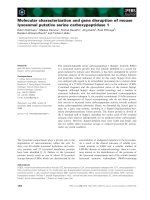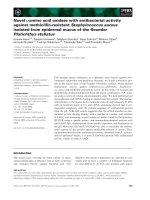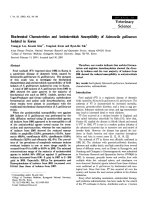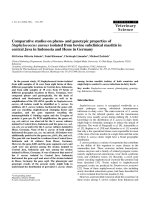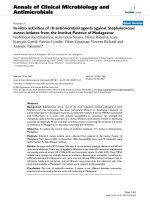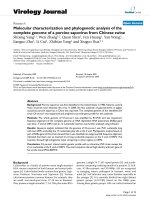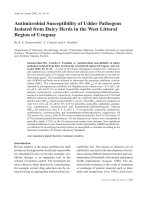Molecular characterization and antimicrobial susceptibility of Staphylococcus aureus isolated from children with acute otitis media in Liuzhou, China
Bạn đang xem bản rút gọn của tài liệu. Xem và tải ngay bản đầy đủ của tài liệu tại đây (665.16 KB, 8 trang )
Ding et al. BMC Pediatrics
(2018) 18:388
/>
RESEARCH ARTICLE
Open Access
Molecular characterization and
antimicrobial susceptibility of
Staphylococcus aureus isolated from
children with acute otitis media in Liuzhou,
China
Yan Ling Ding1†, Jinjian Fu1†, Jichang Chen2†, Sheng Fu Mo1†, Shaolin Xu1, Nan Lin3, Peixu Qin1 and
Eric McGrath4,5*
Abstract
Background: There have been few studies focused on the prevalence, bacterial etiology, antibiotic resistance, and
genetic background of Staphylococcus aureus (S. aureus) in children with acute otitis media (AOM) in China.
Methods: A retrospective study was conducted in Liuzhou Maternity and Child Healthcare Hospital. Patients
younger than 18 years diagnosed with AOM were enrolled in the study. Middle ear fluid specimens were collected
and cultured for bacterial pathogens. The antibiotic susceptibility, virulence genes, macrolide resistant genes and
sequence types of S. aureus were identified.
Results: From January 1, 2013 to December 31, 2015, a total of 228 cases of AOM were identified. Pathogenic
bacteria were positive in 181 (79.4%) of 228 specimens. Streptococcus pneumoniae was the most common bacteria
(36.4%), followed by S. aureus (16.2%). Among the 37 S. aureus isolates, 12 (23.5%) were methicillin-resistant S. aureus
(MRSA), and 25 (77.5%) were methicillin-susceptible S. aureus (MSSA). A total of 23 isolates (62.2%) were resistant to
erythromycin, 40.5% of isolates were resistant to clindamycin, and 37.8% isolates were resistant to tetracycline.
Twenty-three isolates were multi-drug resistant (MDR) S. aureus. Eighteen isolates carried the pvl gene. Up to 22 (59.
4%) isolates expressed ermA gene, 8 (21.6%) isolates expressed both ermA and ermC genes, and only 8.1%
expressed ermB. Among all S.aureus isolates, 7 sequence types (STs) were identified by multilocus sequence typing
(MLST). The most common ST was ST59 (16/37, 43.2%), followed by ST45 (7/37, 18.9%) and ST30 (7/37, 18.9%). The
predominant MSSA isolates were ST59-t437-MSSA (5/25, 20.0%), the prevailing MRSA isolates were Taiwan related
strains ST59-SCCmec-IVa/V (5/12, 41.6%).
Conclusions: S. aureus was the second most common cause for AOM in children in Liuzhou. Most of the S. aureus
was MDR which carried a high proportion of ermA and ermC gene. CA-MRSA (ST59-SCCmec-IV/V-t437) is circulating
in children with AOM. These findings support continued surveillance of S. aureus infections in children with AOM in
both communities and hospitals.
Keywords: Staphylococcus aureus, Acute otitis media, Antibiotic resistance, Genetic background, Pediatrics
* Correspondence:
†
Yan Ling Ding, Jinjian Fu, Jichang Chen and Sheng Fu Mo contributed
equally to this work.
4
Children’s Hospital of Michigan, Detroit, MI, USA
5
Department of Pediatrics, Wayne State University School of Medicine, 3901
Beaubien Blvd, Detroit, MI 48201, USA
Full list of author information is available at the end of the article
© The Author(s). 2018 Open Access This article is distributed under the terms of the Creative Commons Attribution 4.0
International License ( which permits unrestricted use, distribution, and
reproduction in any medium, provided you give appropriate credit to the original author(s) and the source, provide a link to
the Creative Commons license, and indicate if changes were made. The Creative Commons Public Domain Dedication waiver
( applies to the data made available in this article, unless otherwise stated.
Ding et al. BMC Pediatrics
(2018) 18:388
Background
Acute otitis media (AOM) is a common pediatric bacterial infection affecting approximately 80% of children
prior to the age of 3 years [1]. The incidence of AOM in
Chinese children was reported to be between 57.2 and
69.4% in children age 0–2 years [2]. AOM is the primary
reason for the prescription of antibiotics in children [3].
The extensive use of antibiotics has been a public health
problem in China [4]. Understanding the epidemiology
and the etiology of AOM is important for the clinical selection of empiric treatment.
It was reported that the incidence of pediatric AOM
and the causative pathogens varied among different regions and geographic settings. Although Streptococcus
pneumoniae (S. pneumoniae), Haemophilus influenzae
(H. influenzae), and Moraxella catarrhalis (M. catarrhalis) are the three leading causes of AOM in children [5],
it was noted that the primary bacteria responsible for
AOM in Chinese children are S. pneumoniae, Staphylococcus aureus (S. aureus) and H. influenzae [2]. S. aureus
was considered a major pathogen that led to infection
and hospitalization in pediatric patients, including
healthy subjects in the community in past decades [6, 7].
Although methicillin-resistant Staphylococcus aureus
(MRSA) causing pediatric infections such as skin and
soft tissue infections, pneumonia, and blood stream
infections are well documented, detailed studies of the
contribution
of
S.aureus
(both
MRSA
and
methicillin-sensitive Staphylococcus aureus, MSSA) to
AOM are limited. There have been few studies focused
on the epidemiology of pediatric AOM in China. The
aim of this study was to both evaluate the bacterial etiology of AOM and the antibiotic resistance patterns of
S. aureus in pediatric AOM disease and investigate the
molecular features and genetic background of S. aureus
AOM in children from western China.
Methods
Patients and sample collections
This retrospective study was conducted between January
1, 2013 and December 31, 2015 in the otolaryngology
clinic of Liuzhou Maternity and Child Healthcare Hospital. Patients younger than 18 years were enrolled in the
study. The diagnostic criteria for AOM was based on the
International Classification of Diseases, ninth version,
Clinical Modification (ICD-9-CM) code 3810, 3820, or
3829 [3]. Any child diagnosed with chronic otitis media,
or who had prior history of tympanostomy tube insertion, cholesteatomas, or otitis externa were excluded.
Spontaneous ear pus drainage from the deep ear canal
was swabbed by otolaryngologists and then sent to the
microbiology laboratory.
The specimens were immediately plated on Columbia
agar containing 5% sheep blood, on chocolate agar and
Page 2 of 8
on MacConkey agar. All agars were placed in 35–37 °C,
5–10% CO2 incubated for 24 h to 48 h. The suspected
bacteria were identified using VITEK 2 compact automatic microbial analysis system (Biomérieux, Marcyl’
Etoile, France).
Antimicrobial susceptibility test
Antimicrobial susceptibility test of S. aureus was performed using the Gram-positive cocci antibiotic cards
(Biomérieux, Marcyl’ Etoile, France). Minimum inhibitory concentrations (MICs) were proposed using
in-house prepared panels according to Clinical and Laboratory Standards Institute (CLSI) guidelines [8]. Isolates not susceptible to at least 3 different antibiotic
classes such as β-lactams, macrolides, and glycopeptides
were defined as multidrug-resistant (MDR) S. aureus.
Detection of the mecA, Panton-Valentine Leukocidin (pvl)
and erythromycin-resistance genes
The mecA and lukS-PV or lukF-PV genes (both of which
encode for pvl) were detected as described previously
[9]. The macrolide resistance genes ermA, ermB and
ermC were amplified by PCR methods for all
erythromycin-resistance isolates [10].
SCCmec typing
The staphylococcal cassette chromosome mec (SCCmec)
was distinguished by the updated multiplex PCR assay
developed by Zhang K et al. [11].
Multilocus sequence typing (MLST)
MLST was performed by PCR amplification and sequencing of 7 housekeeping genes by using primers and protocols described previously [12]. DNA sequences were
submitted to the MLST database website (www.mlst.net)
for the generation of an allelic profile and sequence type
(ST).
Spa typing
Spa typing was determined by using established method
[13]. Sequences were submitted to the RIDOM web server () for assignment of the spa
type.
Statistical analysis
Data were analyzed using descriptive statistics and χ2
tests. The two-sided p-value for statistical significance
was defined as p < 0.05. All statistical analyses were
conducted using SPSS version 20.0 (SPSS Inc. Chicago, Il, USA).
(2018) 18:388
Ding et al. BMC Pediatrics
Page 3 of 8
Results
Table 2 Microbiology of middle ear fluid from children with
acute otitis media
Epidemiology and microbiology
Two hundred and twenty-eight children age 0–15 years
were identified with AOM in the otolaryngology clinic
during the study period. The median age was 24 months.
Sixty-six percent of them were less than 2 years. The
male-to-female ratio was 1:0.6. (Table 1). Pathogenic
bacteria were positive in 181 (79.4%) of 228 specimens,
S. pneumoniae was the most common bacteria (36.4%),
followed by S. aureus (16.2%), Pseudomonas aeruginosa
(4.4%) and H. influenzae (3.9%) (Table 2).
Among the 37 S. aureus isolates, 12 (23.5%) were
MRSA, and 25 (77.5%) were MSSA. All isolates were
susceptible to ciprofloxacin, rifampicin, linezolid and
vancomycin. A total of 23 isolates (62.2%) were resistant
to erythromycin, and 37.8% isolates were resistant to
tetracycline. The resistant rate to clindamycin was
higher in the MSSA group than in the MRSA group (p
= 0.040) (Table 3). Twenty-three isolates were
multi-drug resistant (MDR) S. aureus. In the MRSA
group, the MDR rate was 83.3%, while in the MSSA
group, the MDR rate was 52.0%. The most common
MDR pattern was resistance to penicillin/erythromycin
/clindamycin/tetracycline.
Virulence and macrolide-resistance genes
Eighteen S. aureus isolates carried the pvl gene. The pvl
gene distribution varied between the MRSA and the
MSSA groups, with 9 MRSA isolates (75.0%) and 9
MSSA isolates (36.0%) carring the pvl gene, with MRSA
isolates having a higher proportion than the MSSA
group (χ2 = 4.94, p = 0.026). Up to 22 (59.4%) isolates
expressed the ermA gene, and 8 (21.6%) isolates
expressed both ermA and ermC genes, and only 8.1%
expressed ermB. Eighty-three and 41 % of MRSA isolates
expressed ermA and ermC genes, respectively, while only
12 (32.4%) and 4 (10.8%) of MSSA isolates expressed
ermA and ermC gene, which was significantly different
(p = 0.016, and 0.002, respectively) (Table 4).
Table 1 The demographic information of children with AOM
Characteristic
AOM
Staphylococcus aureus positive
N
%
N
%
Male
141
61.8
21
56.8
Female
87
38.2
14
43.2
<1
106
46.5
17
45.9
1-
46
20.2
8
21.6
2-
49
21.5
7
18.9
≥5
27
11.8
5
13.5
Gender
Age (years)
Pathogen
No. of strains (%)
No growth
47 (20.6)
Any growth
181 (79.4)
Streptococcus pneumoniae
83 (36.4)
Staphylococcus aureus
37 (16.2)
Haemophilus influenzae
9 (3.9)
Streptococcus pyogenes
4 (1.7)
Moraxella catarrhalis
1 (0.4)
Candida albicans
5 (2.2)
Fungus
6 (2.6)
Pseudomonas aeruginosa
10 (4.4)
Klebsiella pneumoniae
4 (1.7)
Escherichia coli
3 (1.3)
Proteus mirabilis
2 (0.8)
Molecular typing
Among the 12 MRSA isolates, 4 (33.3%) belonged to
SCCmec type IVa, 5 (41.6%) belonged to SCCmec type
IV, and 3 (25.8%) belonged to SCCmec type V. Twelve
Spa types were identified, t437 (13/37, 35.1%) was the
most common type, followed by t037 (6/37, 16.2%), and
t021 (4/37, 10.8%). The t437 (8/12, 75.0%) and t437 (5/
25, 20.0%) type was the most common Spa type in the
MRSA and the MSSA groups, respectively.
Among all S. aureus isolates, 7 sequence types (STs)
were identified by MLST. The most common ST was
ST59 (16/37, 43.2%), followed by ST45 (7/37, 18.9%) and
ST30 (7/37, 18.9%) (Table 5). The predominant MSSA
isolates were ST59-t437-MSSA (5/25, 20.0%), the second
predominant MSSA were southwest-pacific strains
ST30-t037-MSSA (4/25, 16.0%). The prevailing MRSA
isolates were Taiwan related strains ST59-SCCmec-IVa/V
(5/12, 41.6%), most of them were found among children
older than 2 years (4/5, 80.0%). The Berlin strains
ST45-SCCmec- IVa/V (2/12, 16.7%) were found in 2 infants aged 3 months. In the ST59-SCCmec-IV/IVa/
V-t437 clone, the antibiotic resistant profile was erythromycin/clindamycin
/tetracycline.
Moreover,
the
ST59-SCCmec-IV/V-t437 clone showed high resistance
to erythromycin, clindamycin, and tetracycline, which
was 88.9, 88.9, and 44.5%, respectively. Additionally,
ST59 was the most frequent ST in pvl positive isolates,
including 2 SCCmec type IV, 2 SCCmec type IVa, and 2
SCCmec type V. Other STs found in pvl positive isolates
included ST30 (3 MSSA, 1 MRSA), ST45 (2 MSSA, 2
MRSA), and ST59 MSSA (4 isolates). Figure 1 showed
the pvl gene distribution among the CC30, CC45 and
CC59 strains, with a high proportion of pvl gene distribution in CC59 strains.
Ding et al. BMC Pediatrics
(2018) 18:388
Page 4 of 8
Table 3 Antimicrobial susceptibilities of Staphylococcus aureus isolated from children with AOM
Antibiotic
Susceptibilities rate (%)
Penicillin
P
value
Overall (n = 37)
MSSA (n = 25)
MRSA (n = 12)
4 (10.8)
4 (16.0)
0 (0.0)
0.282
Gentamicin
35 (94.6)
23 (92.0)
12 (100.0)
1.000
Erythromycin
14 (37.8)
12 (48.0)
2 (16.7)
0.066
Tetracycline
23 (62.2)
16 (64.0)
7 (58.3)
0.739
Ciprofloxacin
37 (100.0)
25 (100.0)
12 (100.0)
1.000
Clindamycin
15 (40.5)
13 (52.0)
2 (16.7)
0.040
Sulfamethoxazole- trimethoprim
36 (97.3)
24 (96.0)
12 (100.0)
1.000
Chloramphenicol
36 (97.3)
25 (100.0)
11 (91.7)
1.000
Rifampicin
37 (100.0)
25 (100.0)
12 (100.0)
1.000
Linezolid
37 (100.0)
25 (100.0)
12 (100.0)
1.000
Vancomycin
37 (100.0)
25 (100.0)
12 (100.0)
1.000
Discussion
AOM is a disease with worldwide prevalence having
broad disease burden and may require prolonged treatment courses because at least a third of children have
two or more episodes of AOM (recurrent AOM) in the
first three years of life [14]. Reliable epidemiological data
on etiology and burden of AOM are important as the
data help clinicians with the selection of appropriate empiric antibiotic therapy for pediatric AOM and for public
health policy decision-making.
In this retrospective study, we found that S. pneumoniae and S. aureus were the most predominant etiologic
agents causing AOM, being isolated in 36.4 and 16.2% of
the specimens of children with AOM, respectively. Most
of the S. aureus was MDR and resistant to erythromycin,
clindamycin and tetracycline. The first two antibiotics
(erythromycin and clindamycin) were the most frequent
medicines prescribed by Chinese pediatricians for infectious diseases [4]. Historically, the major bacteria responsible for most cases of AOM were S. pneumoniae
and H. influenzae [15]. The etiology of the pathogenic
bacteria does not appear to have changed significantly
Table 4 Prevalence of erythromycin resistant genes among
Staphylococcus aureus isolated from children with AOM
No. of
positive
isolates
(%)
No. distributing in
MSSA (n = 25)
MRSA (n = 12)
ermA
22 (59.4)
12 (32.4)
10 (83.3)
0.002
ermB
3 (8.1)
1 (2.7)
2 (16.7)
0.144
ermC
9 (24.3)
4 (10.8)
5 (41.7)
0.016
ermA+ermC
8 (16.3)
4 (10.8)
4 (33.3)
0.067
ermA+ermB
2 (5.4)
0 (0.0)
2 (16.7)
1.000
ermB+ermC
1 (2.7)
0 (0.0)
1 (8.3)
1.000
ermA+ermB+ermC
1 (2.7)
0 (0.0)
1 (8.3)
1.000
Gene
P
value
over time. Since the prevalence and the main causal
agents of AOM varied by geographic location, we observed a different epidemiology and etiology from previous studies [1, 3, 5] which revealed that the most causal
agents of AOM were S. pneumoniae and H. influenzae,
but our study was in line with one study conducted in
southern China which demonstrated that the major
pathogens causing AOM were S. pneumoniae and S.
aureus, which accounted for 47.2 and 18.5% of the specimens isolated from AOM patients, respectively [2]. It
has been reported that in the era of universal pneumococcal conjugate vaccine (PCV) immunization, that H.
influenzae may become the predominant pathogen of
AOM, suggesting that the introduction of PCV7 can
change the relative prevalence of main causal agents
[16]. The same result was observed in Saudi children,
after the introduction of pneumococcal vaccines in the
routine immunization schedule, S. aureus has become
the most predominant contributor to AOM [17]. The
determinants of why S. aureus has become the second
most common causal agent of AOM in China is poorly
understood. In China, as the H. influenza b vaccine and
PCV were self-paid and did not enter into the Chinese
Expanded Program on Immunizations (EPI), we didn’t
see the changes of pathogen patterns distributed in the
AOM disease for the vaccination of H. influenza b vaccine and PCV. The low coverage of PCV7 and antibiotic
overuse and abuse in China can partly explain this disparity [2]. In this region of the world, S. aureus should
be considered and targeted with appropriate therapy if
initial therapies targeting S. pneumoniae fail to lead to
clinical improvement, especially if culture is not
available.
Antibiotic resistance has become an important public
health problem in mainland China. Restriction of
β-lactam use in MRSA infections required use of other
types of antibiotic options for treatment. However,
Ding et al. BMC Pediatrics
(2018) 18:388
Page 5 of 8
Table 5 Molecular characteristics and antibiotic resistance profiles of Staphylococcus aureus isolated from children with AOM
Variables
MRSA (n = 12)
MSSA (n = 25)
SCCmec (n)
IV (5), IVa(4), V(3)
–
CCs (n)
CC30(1),CC45(2),CC59(9)
CC30(6),CC188(1), CC45(5),CC59(7), CC88(1), CC942(2)
STs(n)
ST30(1),ST45(2),ST59(9)
ST188(13),ST30(6), ST398(1),ST45(5), ST59(7), ST88(1),ST942(2)
Spa (n)
t037(1),t0181(2),t3845(1),t437(8) t021(4),t037(5),t1081(1),t1445(32), t189(3),t2592(1),t3551(1),
t3590(1),t3736(1),t437(5),t571(1)
pvl(n)
9
9
erm-resistant genes (n)
ermA(10).ermC(5),ermB(2)
ermA(2).ermC(4),ermB(1)
Antibiotir resistance profiles
(n)
P(12),E(10),DA(10),Cl(1),TE(5)
P(21),SXT(1),GN(2),E(13),DA(12),TE(9)
MLSBi (n)
3
4
P penicillin, E erythromycin, GN gentamicin, TE tetracycline, DA clindamycin, Cl chloramphenicol, SXT Sulfamethoxazole- trimethoprim
except for resistance to all kind of β-lactam antibiotics,
the MRSA isolates found in our study developed a high
resistant rate to non-β-lactam antibiotics, especially to
erythromycin, clindamycin and tetracycline. We found
that the resistance rate to clindamycin in MSSA is even
higher than in MRSA isolates. It was reported that both
erythromycin and clindamycin have been common prescribed antibiotics for S. aureus infection [18]. A high resistance rate was also reported in mainland China [19],
which indicated that the high antibiotic resistance rate
of S. aureus is a common public health problem in
China and that the two antibiotics were not the priority
options for the empiric antibiotic therapy in pediatric infections. It was previously reported that in the macrolide
resistance isolates, there were 59.4, 24.3, and 21.6% of
which carried ermA, ermC and both ermA and ermC
gene, respectively. Our study was consistent with a previous report that showed that of resistant S. aureus isolates, 37.7% had ermA, 26.6% had ermC and 18.6% had
both ermA and ermC genes [20], but different from a
study conducted in Turkey which showed that 50% of
ermA positive isolates also carried the ermC gene [10].
Fig. 1 The pvl gene distribution among S. aureus isolates
As a pathogen with extremely high prevalence, S. aureus causes various clinical infections such as skin and
soft
tissue
infections
(SSTIs)
[19],
invasive
community-acquired MRSA (CA-MRSA) infections [21],
and pneumonia [22]. Few studies about MRSA and
MSSA isolates contemporaneously circulating among
age-specific groups of children attending otolaryngology
clinics have been examined [23, 24]. According to the
previous report [11], hospital-acquired MRSA
(HA-MRSA) is usually detected with SCCmec type I, II
and III, while CA-MRSA is usually detected with
SCCmec type IV, IVa and V. In this study, all of the
MRSA isolates carried SCCmec IV, IVa and V, which
confirmed that these MRSA isolates belonged to
CA-MRSA. Twelve Spa types and seven ST types clustered into 7 clonal complex (CCs) among MSSA and 3
CCs among MRSA were observed in our study, indicating that there is great genetic diversity in S. aureus isolated from AOM patients. MSSA isolates with a genetic
background (ST30-t037, ST45-t1081 and ST59-t437)
was common to MRSA clones in this study suggesting
that these MSSA isolates might have the potential to become CA-MRSA clones once acquisition of the mecA
gene occurs [21].
Despite the high prevalence, only a few epidemic
clones have been identified in China [25–27]. Previous
studies throughout mainland China found that ST59SCCmec-IVa/V strains were the most common strains
causing CA-MRSA infections among children [25–28].
Our study also confirmed that the predominant sequence type of MRSA isolated from AOM children was
ST59, which accounted for 75% of all the MRSA isolates.
The previous report of ST59 was detected from a few
MSSA isolates and in a single MRSA isolate in the
United States, a large proportion of ST59 emerging in
Taiwan was reported in 2004 and ST59-MRSA was
called Taiwan clone [29]. ST59 was not only predominant in Shanghai [30], Guangzhou [31], and Taiwan [29],
but also served as prevailing strains in Hongkong [32]
Ding et al. BMC Pediatrics
(2018) 18:388
and Vietnam [33]. The Asian Network for Surveillance
of Resistant Pathogens (ANSORP) study conducted in
17 hospitals from Asian countries demonstrated that the
predominant clones of CA-MRSA isolates were
ST59-MRSA-SCCmec type IV-spa type t437 [34]. These
findings suggested that ST59 is currently spreading between adjacent regions and supporting its dominance in
the Asian region as a whole [33]. It is widely assumed
that the CA-MSSA isolates acquiring the resistance gene
mecA would become the major sources of CA-MRSA. In
our study, we observed that ST59-MSSA was the predominant sequence type in the MSSA group, accounting
for 28% of all MSSA isolates, which indicated that the S.
aureus isolates undergoing genetic variations have great
capacities for environmental adaption. The similar genetic background of ST59 between MRSA and MSSA isolates was also observed in ST30 and ST45 in our study.
ST45 was the second prevailing ST in our study, accounting for 20% of MSSA and 16.7% of MRSA isolates. It
was reported that clonal complex 45 (CC45) is common
throughout European countries such as Germany and the
Netherlands and Belgium [35]. The ST45-SCCmec-IV/
V-t437 clone is well known as the Berlin clone. The Berlin
clone was first observed in 1993, and its emergence was
attributed to acquisition of mecA by a community clone of
MSSA [36]. The ST45 now spread in Hongkong [35] and
mainland China [37], including in western China where
our study was conducted. It was speculated that CC45
strains may be more transmissible among health care settings and hospitals [35].
One of the interesting findings was that ST398-MSSA
was found in this study. ST398 is considered as a
livestock-associated pathogen mainly affecting people in
contact with major animal reservoirs [38]. It is noteworthy that this AOM case with isolates of ST398 reported no direct livestock-associated risk factors,
although many reports documented that persons living
in places of high livestock density were found to have a
greater chance of livestock-associated CC398 carriage
even if they lacked direct contact with animals [39, 40].
CC398 may now be sporadic and distributed in China
including areas such as Shanghai [30] and Liuzhou. This
study finding suggests the probability of CC398 transmission via human contact instead of animal contact [41].
Panton-Valentine leukocidin (PVL) is a bicomponent
toxin that can cause the lysis of leucocytes and it is a
main virulence factor of S. aureus which is responsible
for severe invasive disease such as necrotizing pneumonia [30]. An important finding in this study was the high
detection rate of the pvl gene in S. aureus isolates, with
significant differences between the MRSA and the MSSA
groups. Our result was consistent with previous reports
indicating that the pvl gene was more common in
MRSA isolates than in MSSA isolates [42]. Several
Page 6 of 8
studies found that the proportion of pvl positivity was
approximately 27–40% among S.aureus isolates detected
from children in mainland China [30]. In the current
study, the pvl gene was found in ST30, ST45 and ST59
clones. It was reported that CA-MRSA ST59 isolates
had significantly more pronounced virulence than the
geographically matched HA-MRSA clones ST239 in
various animal models, including the pvl gene [43]. The
CC59 was predominant among pvl positive CA-MRSA
in mainland China [30], for example, Li et al. [44] reported 55.5% of CC59 MRSA isolates to be pvl positive
in China, while we detected 66.7% of CC59 MRSA isolates with pvl positive in AOM disease.
There are some limitations to our study. First of all,
the single-center design and the small number of AOM
patients may limit the generalizability of our study results. Secondly, the AOM cases in this study may not accurately represent all AOM cases as we swabbed
spontaneous ear pus drainage from the deep ear canal
and the external auditory canal to culture organisms, the
results of which may or may not have included the true
middle ear pathogen. S.aureus may have been a leading
cause of AOM, but as we swabbed the ear canal, this
may lead to detection of some colonizing agents such as
S.aureus. Lastly, a retrospective review of medical records for identifying patients presented to an Otolaryngology clinic may have potentially decreased the
generalizability of the results, as some children may have
had more severe disease which were referred to a surgeon, as opposed to a primary care provider.
Conclusion
In conclusion, S. aureus was a leading cause for AOM in
children in Liuzhou. Most of the S. aureus was MDR
and carried high proportion of ermA and ermC gene.
CA-MRSA (ST59-SCCmec-IV/V-t437) is circulating in
children with AOM, suggesting a potential for
CA-MRSA transmission from community to hospital.
These findings support growing concern about continued surveillance of S. aureus infections in both communities and hospitals, and raise questions about the
routine antibiotic use for the treatment of S. aureus infections in China and in countries worldwide.
Abbreviations
ANSORP: Asian Network for Surveillance of Resistant Pathogens; AOM: Acute
otitis media; CA-MRSA: Community-acquired MRSA; CCs: Clonal complexs;
CLSI: Clinical and Laboratory Standards Institute; EPI: Expanded Program on
Immunization; H. influenzae: Haemophilus influenzae; HA-MRSA: hospitalacquired MRSA; M. catarrhalis: Moraxella catarrhalis; MDR: Multi-drug resistant;
MICs: Minimum inhibitory concentrations;; MLST: Multilocus Sequence
Typing; MRSA: Methicillin- resistant S.aureus; MSSA: Methicillin-susceptible
S.aureus; PCV: Pneumococcal conjugate vaccine; pvl: Panton-Valentine
Leukocidin; S. pneumoniae: Streptococcus pneumoniae; S.aureus: Staphylococcus
aureus; SCCmec: Staphylococcal cassette chromosome mec; SSTIs: Skin and
soft tissue infections; STs: Sequence types
Ding et al. BMC Pediatrics
(2018) 18:388
Page 7 of 8
Acknowledgements
Not applicable.
8.
Funding
This manuscript was funded by Guangxi Natural Science Foundation (No.
2015GXNSFBA139129) and Guangxi Medical and Health Self-funding Project
(No Z20170509 and No Z20180022). The funders had no role in study design,
data collection and analysis, decision to publish, or preparation of the
manuscript.
9.
Availability of data and materials
We declare that the data supporting the conclusions of this article are fully
described within the article, and the database is available from the first
author () upon reasonable request.
Authors’ contributions
J C and J F designed the study and drafted an outline. S M and J F
participated in data analysis, J F draft of initial manuscript, N L, S X and P Q
participated in diagnosing AOM and collected the data, E M critically
reviewed and revised the manuscript and all of authors approved the final
content off this manuscript.
10.
11.
12.
13.
14.
Ethics approval and consent to participate
This study was approved by the Institutional Review Board of Liuzhou
Maternity and Child Healthcare Hospital.
15.
Consent for publication
Not applicable.
16.
Competing interests
The authors declare that they have no competing interests.
17.
Publisher’s Note
Springer Nature remains neutral with regard to jurisdictional claims in
published maps and institutional affiliations.
18.
Author details
1
Department of Laboratory, Liuzhou Maternity and Child Healthcare Hospital,
Liuzhou 545001, China. 2Department of Neonatology, Liuzhou Maternity and
Child Health Care Hospital, Liuzhou 545001, China. 3Department of
Otolaryngology, Liuzhou Maternity and Child Health Care Hospital, Liuzhou
545001, Guangxi, China. 4Children’s Hospital of Michigan, Detroit, MI, USA.
5
Department of Pediatrics, Wayne State University School of Medicine, 3901
Beaubien Blvd, Detroit, MI 48201, USA.
19.
20.
21.
Received: 26 June 2018 Accepted: 5 December 2018
22.
References
1. Vergison A, Dagan R, Arguedas A, Bonhoeffer J, Cohen R, Dhooge I, et al.
Otitis media and its consequences: beyond the earache. Lancet Infect Dis.
2010;10(3):195–203.
2. Ding Y, Geng Q, Tao Y, Lin Y, Wang Y, Black S, et al. Etiology and
epidemiology of children with acute otitis media and spontaneous otorrhea
in Suzhou, China. Pediatr Infect Dis J. 2015;34(5):e102–6.
3. Chen YJ, Hsieh YC, Huang YC, Chiu CH. Clinical manifestations and
microbiology of acute otitis media with spontaneous otorrhea in children. J
Microbiol Immunol Infect. 2013 Oct;46(5):382–8.
4. Yao KH, Yang YH. Streptococcus pneumoniae diseases in Chinese children:
past, present and future. Vaccine. 2008 Aug 18;26(35):4425–33.
5. Casey JR, Pichichero ME. Changes in frequency and pathogens causing
acute otitis media in 1995-2003. Pediatr Infect Dis J. 2004 Sep;23(9):824–8.
6. Moran GJ, Krishnadasan A, Gorwitz RJ, Fosheim GE, McDougal LK, Carey RB,
et al. EMERGEncy ID net study group. Methicillin-resistant S. aureus
infections among patients in the emergency department. N Engl J Med.
2006;355(7):666–74.
7. Maree CL, Daum RS, Boyle-Vavra S, Matayoshi K, Miller LG. Communityassociated methicillin-resistant Staphylococcus aureus isolates causing
healthcare-associated infections. Emerg Infect Dis. 2007;13(2):236–42.
23.
24.
25.
26.
27.
28.
Clinical Laboratory Standards Institute 2016. Performance standards for
antimicrobial susceptibility testing; 26th informational supplement. Wayne:
CLSI document M100-S23 Clinical Laboratory Standards Institute.
McClure JA, Conly JM, Lau V, Elsayed S, Louie T, Hutchins W, et al. Novel
multiplex PCR assay for detection of the staphylococcal virulence marker
Panton-valentine leukocidin genes and simultaneous discrimination of
methicillin-susceptible from -resistant staphylococci. J Clin Microbiol. 2006;
44(3):1141–4.
Yıldız Ö, Çoban AY, Şener AG, Coşkuner SA, Bayramoğlu G, Güdücüoğlu H,
et al. Antimicrobial susceptibility and resistance mechanisms of methicillin
resistant Staphylococcus aureus isolated from 12 hospitals in Turkey. Ann
Clin Microbiol Antimicrob. 2014;13:44.
Zhang K, McClure JA, Conly JM. Enhanced multiplex PCR assay for typing of
staphylococcal cassette chromosome mec types I to V in methicillinresistant Staphylococcus aureus. Mol Cell Probes. 2012;26(5):218–21.
Enright MC, Day NP, Davies CE, Peacock SJ, Spratt BG. Multilocus sequence
typing for characterization of methicillin-resistant and methicillin-susceptible
clones of Staphylococcus aureus. J Clin Microbiol. 2000;38(3):1008–15.
Harmsen D, Claus H, Witte W, Rothgänger J, Claus H, Turnwald D, et al.
Typing of methicillin-resistant Staphylococcus aureus in a university hospital
setting by using novel software for spa repeat determination and database
management. J Clin Microbiol. 2003;41(12):5442–8.
Marchisio P, Nazzari E, Torretta S, Esposito S, Principi N. Medical prevention
of recurrent acute otitis media: an updated overview. Expert Rev Anti-Infect
Ther. 2014;12(5):611–20.
Sierra A, Lopez P, Zapata MA, Vanegas B, Castrejon MM, Deantonio R, et al.
Non-typeable Haemophilus influenzae and Streptococcus pneumoniae as
primary causes of acute otitis media in colombian children: a prospective
study. BMC Infect Dis. 2011;11:4.
Leibovitz E, Jacobs MR, Dagan R. Haemophilus influenzae: a significant
pathogen in acute otitis media. Pediatr Infect Dis J. 2004;23:1142–52.
Al-Mazrou KA, Shibl AM, Kandeil W, Pirçon JY, Marano C. A prospective,
observational, epidemiological evaluation of the aetiology and antimicrobial
susceptibility of acute otitis media in Saudi children younger than 5years of
age. J Epidemiol Glob Health. 2014 Sep;4(3):231–8.
Changchien CH, Chen YY, Chen SW, Chen WL, Tsay JG, Chu C. Retrospective
study of necrotizing fasciitis and characterization of its associated methicillinresistant Staphylococcus aureus in Taiwan. BMC Infect Dis. 2011;11:297.
Rodriguez M, Hogan PG, Burnham CA, Fritz SA. Molecular epidemiology of
Staphylococcus aureus in households of children with community-associated
S aureus skin and soft tissue infections. J Pediatr. 2014 Jan;164(1):105–11.
Gul HC, Kilic A, Guclu AU, Bedir O, Orhon M, Basustaoglu AC. Macrolidelincosamide-streptogramin B resistant phenotypes and genotypes for
methicillin-resistant Staphylococcus aureus in Turkey, from 2003 to 2006. Pol
J Microbiol. 2008;57(4):307–12.
Qiao Y, Ning X, Chen Q, Zhao R, Song W, Zheng Y, et al. Clinical and
molecular characteristics of invasive community-acquired Staphylococcus
aureus infections in Chinese children. BMC Infect Dis. 2014;14:582.
Defres S, Marwick C, Nathwani D. MRSA as a cause of lung infection
including airway infection, community-acquired pneumonia and hospitalacquired pneumonia. Eur Respir J. 2009;34(6):1470–6.
Kim SH, Kim MG, Kim SS, Cha SH, Yeo SG. Change in detection rate of
methicillin-resistant Staphylococcus aureus and Pseudomonas aeruginosa
and their antibiotic sensitivities in patients with chronic Suppurative otitis
media. J Int Adv Otol. 2015;11(2):151–6.
Rath S, Das SR, Padhy RN. Surveillance of bacteria Pseudomonas aeruginosa
and MRSA associated with chronic suppurative otitis media. Braz J
Otorhinolaryngol. 2017;83(2):201–6.
Geng W, Yang Y, Wang C, Deng L, Zheng Y, Shen X. Skin and soft tissue
infections caused by community-associated methicillin-resistant staphylococcus
aureus among children in China. Acta Paediatr. 2010 Apr;99(4):575–80.
Geng W, Yang Y, Wu D, Huang G, Wang C, Deng L, et al. Molecular
characteristics of community-acquired, methicillin-resistant Staphylococcus
aureus isolated from Chinese children. FEMS Immunol Med Microbiol. 2010;
58(3):356–62.
Zhang W, Shen X, Zhang H, Wang C, Deng Q, Liu L, et al. Molecular
epidemiological analysis of methicillin-resistant Staphylococcus aureus isolates
from Chinese pediatric patients. Eur J Clin Microbiol Infect Dis. 2009;28(7):861–4.
Geng W, Yang Y, Wu D, Zhang W, Wang C, Shang Y, et al. Community-acquired,
methicillin-resistant Staphylococcus aureus isolated from children with
community-onset pneumonia in China. Pediatr Pulmonol. 2010;45(4):387–94.
Ding et al. BMC Pediatrics
(2018) 18:388
29. Wang CC, Lo WT, Chu ML, Siu LK. Epidemiological typing of communityacquired methicillin-resistant Staphylococcus aureus isolates from children
in Taiwan. Clin Infect Dis. 2004;39(4):481–7.
30. Song Z, Gu FF, Guo XK, Ni YX, He P, Han LZ. Antimicrobial resistance and
molecular characterization of Staphylococcus aureus causing childhood
pneumonia in Shanghai. Front Microbiol. 2017;8:455.
31. Liu Y, Wang H, Du N, Shen E, Chen H, Niu J, et al. Molecular evidence for
spread of two major methicillin-resistant Staphylococcus aureus clones with
a unique geographic distribution in Chinese hospitals. Antimicrob Agents
Chemother. 2009;53(2):512–8.
32. Ho PL, Chuang SK, Choi YF, Lee RA, Lit AC, Ng TK, et al. Hong Kong CAMRSA surveillance network. Community-associated methicillin-resistant and
methicillin-sensitive Staphylococcus aureus: skin and soft tissue infections in
Hong Kong. Diagn Microbiol Infect Dis. 2008;61(3):245–50.
33. Vu BN, Jafari AJ, Aardema M, Tran HK, Nguyen DN, Dao TT, et al. Population
structure of colonizing and invasive Staphylococcus aureus strains in
northern Vietnam. J Med Microbiol. 2016;65(4):298–305.
34. Song JH, Hsueh PR, Chung DR, Ko KS, Kang CI, Peck KR, et al. ANSORP study
group. Spread of methicillin-resistant Staphylococcus aureus between the
community and the hospitals in Asian countries: an ANSORP study. J
Antimicrob Chemother. 2011;66(5):1061–9.
35. Ho PL, Chow KH, Lo PY, Lee KF, Lai EL. Changes in the epidemiology of
methicillin-resistant Staphylococcus aureus associated with spread of the
ST45 lineage in Hong Kong. Diagn Microbiol Infect Dis. 2009;64(2):131–7.
36. Witte W. Antibiotic resistance in gram-positive bacteria: epidemiological
aspects. J Antimicrob Chemother. 1999;44:1–9.
37. Wang L, Liu Y, Yang Y, Huang G, Wang C, Deng L, et al. Multidrug-resistant
clones of community-associated meticillin-resistant Staphylococcus aureus
isolated from Chinese children and the resistance genes to clindamycin and
mupirocin. J Med Microbiol. 2012;61(9):1240–7.
38. Reynaga E, Navarro M, Vilamala A, Roure P, Quintana M, Garcia-Nuñez M, et
al. Prevalence of colonization by methicillin-resistant Staphylococcus aureus
ST398 in pigs and pig farm workers in an area of Catalonia Spain. BMC
Infect Dis. 2016;16(1):716.
39. Feingold BJ, Silbergeld EK, Curriero FC, van Cleef BA, Heck ME, Kluytmans
JA. Livestock density as risk factor for livestock-associated methicillinresistant Staphylococcus aureus, the Netherlands. Emerg Infect Dis. 2012;
18(11):1841–9.
40. Kuehn B. MRSA may move from livestock to humans. JAMA. 2012;308(17):1726.
41. Ye X, Fan Y, Wang X, Liu W, Yu H, Zhou J, et al. Livestock-associated
methicillin and multidrug resistant S. aureus in humans is associated with
occupational pig contact, not pet contact. Sci Rep. 2016;6:19184.
42. Kuehnert MJ, Kruszon-Moran D, Hill HA, McQuillan G, McAllister SK, Fosheim
G, et al. Prevalence of Staphylococcus aureus nasal colonization in the
United States, 2001-2002. J Infect Dis. 2006;193(2):172–9.
43. Li M, Dai Y, Zhu Y, Fu CL, Tan VY, Wang Y, et al. Virulence determinants
associated with the Asian community-associated methicillin-resistant
Staphylococcus aureus lineage ST59. Sci Rep. 2016;6:27899.
44. Li J, Wang L, Ip M, Sun M, Sun J, Huang G, et al. Molecular and clinical
characteristics of clonal complex 59 methicillin-resistant Staphylococcus
aureus infections in mainland China. PLoS One. 2013;8(8):e70602.
Page 8 of 8

